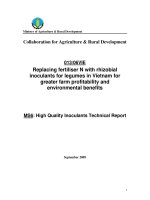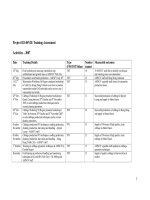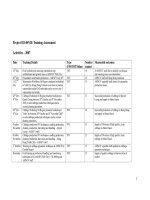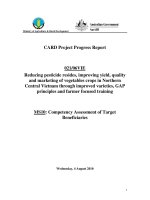Báo cáo khoa học nông nghiệp " Improving traditional integrated farming systems (VAC) – a new livelihood option for poor farmers in the coastal communities " MS2 pot
Bạn đang xem bản rút gọn của tài liệu. Xem và tải ngay bản đầy đủ của tài liệu tại đây (39.88 KB, 7 trang )
1
Ministry of Agriculture & Rural Development
Collaboration for Agriculture and Rural Development
PROJECT PROGRESS REPORT
027/07VIE
Improving traditional integrated farming systems (VAC)
– a new livelihood option for poor farmers
in the coastal communities
MS2: First six-monthly report
5
th
February 2008- 5
th
July 2008
1
Table of Contents
1. Institute Information ___________________________________________________ 2
2. Project Abstract _______________________________________________________ 3
3. Executive Summary ____________________________________________________ 3
4. Introduction & Background _____________________________________________ 3
5. Progress to Date _______________________________________________________ 4
5.1 Implementation Highlights ________________________________________________ 4
5.2 Smallholder Benefits______________________________________________________ 4
5.3 Capacity Building ________________________________________________________ 5
5.4 Publicity________________________________________________________________ 5
5.5 Project Management _____________________________________________________ 5
6. Report on Cross-Cutting Issues___________________________________________ 5
6.1 Environment ____________________________________________________________ 5
6.2 Gender and Social Issues __________________________________________________ 5
7. Implementation & Sustainability Issues ____________________________________ 5
7.1 Issues and Constraints ____________________________________________________ 5
7.2 Options_________________________________________________________________ 6
7.3 Sustainability____________________________________________________________ 6
8. Next Critical Steps _____________________________________________________ 6
9. Conclusion ___________________________________________________________ 6
2
1. Institute Information
Project Name Improving traditional integrated farming systems
(VAC) - a new livelihood option for poor farmers in
the coastal communities
Vietnamese Institution
Centre for Environment and Disease Monitoring in
Aquaculture (CEDMA)
Vietnamese Project Team Leader
Mr. Mai Van Tai (Project director)
Mr. Mai Van Ha (Project manager)
Australian Organisation
Muresk Institute - Division of Science and
Engineering-Curtin University of Technology (CUT)
Australian Personnel
Dr. Ravi Fotedar (Team Leader)
Dr Jane Fewtrell (Environmental Scientist)
Mr Simon Longbottom (Aquaculture Scientist)
Date commenced
8
th
February 2008
Completion date (original)
January 2010
Completion date (revised)
February 2010
Reporting period
6 monthly (First)
Contact Officer(s)
In Australia: Team Leader
Name:
Dr Ravi Fotedar
Telephone:
+61 8 92664508
Position:
International Program
Director, A/Prof
Fax:
+61 8 92664422
Organisation
Muresk Institute, CUT
Email:
In Australia: Administrative contact
Name:
As above
Telephone:
Position:
Fax:
Organisation
Email:
In Vietnam
Name:
Mai Van Ha
Telephone:
0988089305
Position:
Researcher
Fax:
0241840241
Organisation
Centre for Environment and
Disease Monitoring in
Aquaculture (CEDMA)
Email:
3
2. Project Abstract
3. Executive Summary
The overall objective for project 027/07VIE, ‘Improving traditional integrated
farming systems (VAC) - a new livelihood option for poor farmers in the coastal
communities’, is to improve the income base to sustain livelihoods of poor coastal
farmers in the Central provinces. This objective is to be achieved by improving the
productivity of the existing traditional farming system and managing water quality
simultaneously and therefore reducing the environmental impact of operations.
To date the projects achievements have included the design of questionnaire to assess
and document the existing VAC practices in the selected provinces, selection of
demonstration households/farms (VAC), selection of higher value species, transfer of
technology to Vietnamese staff and the design of the improved production systems.
The construction of recirculating aquaculture systems in Nghe an and Quang tri has
commenced. A strategic plan for environment monitoring protocol has been
developed. Two on-field workshops were conducted in March for potential adapters
of new technology in Nghe An and Quang Tri. The first workshop was attended by 21
farmers and commune’s extension workers. The second workshop was attended by 23
farmers and district’s extension staff. Most of the office and laboratory equipment
has been ordered or purchased.
4. Introduction & Background
This project aims to improve efficiency of the traditional VAC system while
decreasing environmental impact through the application of current technology and
introduction of local but higher value species. The objectives are:
i) To carry out an analysis of current economics status and practices of
household farming (includes aquaculture, horticulture and animal
husbandry practices) and identify incentives and constraints for improved
VAC application
The farming communities in the Central coastal areas of Vietnam have very limited productive
land, and marine aquatic resources are overexploited. The diversification of income base for
communities practicing VAC farming systems is a main issue for the local and central
Government. Therefore, the Government is strategically putting in an effort to reduce coastal
exploitation by identifying alternative livelihood options. This project is an appropriate approach
to increase income for these communities using existing available resources. This project is
expected to make a significant contribution to the Government of Vietnam’s Comprehensive
Poverty Reduction and Growth Strategy (CPRGS), which is aligned with the CARD program
strategic framework. So far a survey has been conducted to collect the base line information on the
economic status of farmers participating in traditional VAC farming systems in two selected
districts of Vietnam. The staff from CEDMA have been updated on the proposed improvements in
the traditional VAC farming systems and related environmental issues. The selection of
demonstration sites and aquatic species to be farmed under the modified VAC system has been
finalised. Modifications to the aquaculture production system have been designed and the
constructions of recirculating aquaculture systems are under progress.
4
ii) To develop appropriate improved VAC guidelines and manuals for
household aquaculture in the North Central of Vietnam.
iii) To build capacity for improved VAC application among stakeholders
involving in aquaculture product market chains, especially smallholder
producers.
Objective i) has been completed with the revised performance measures.
As outlined in the log frame, the performance measures are the collection of improved
VAC materials available regionally and internationally; construction of questionnaire
and interviewing of existing farming communities who are participating in the
traditional VAC systems, selection of 2-3 households/farms to demonstrate improved
VAC systems; drafting of action plans for VAC demonstration system which includes
farming of higher value species in a environmentally friendly manner.
To the best of our knowledge the household/farms selected are representative
examples of typical VAC systems of the region.
Activities to meet Objective ii) have commenced.
5. Progress to Date
5.1 Implementation Highlights
Main achievements for this reporting period were;
i) Final signing of contract
ii) First trip to Vietnam (Ravi Fotedar and Jane Fewtrell)
- visited household farm systems practices traditional VAC in Nghe An
and Quang Tri provinces
iii) Formulation of environmental monitoring plan
iv) Formulation and implementation of questionnaire
v) Interviews conducted
vi) Second trip to Vietnam (Ravi Fotedar)
- final selection of demonstration farms
- selection of aquatic species
- update on the technology issues to CEDMA staff and extension
workers
vii) Design of improved aquaculture system to be utilised by the three
demonstration farms finalised (Appendix 3).
viii) Two field workshops conducted
5.2 Smallholder Benefits
At this stage it is expected that the benefits to the house hold farmers will be achieved
as outlined in section 2.2 of the project proposal. The benefits will be quantified
during the second year of the project. To date, the direct benefits in terms of
knowledge of modified VAC operations to small-scale farmers have been achieved
through the workshops run at the two provinces.
5
5.3 Capacity Building
A capacity building initiative has commenced at CEDMA. The transfer of technology
in the area of water recirculating systems in aquaculture, nutrient cycling across
various farming components of VAC system and environmental monitoring programs
have been successfully achieved.
5.4 Publicity
Extension material which includes brochures, posters and single page pamphlets are
under preparation.
5.5 Project Management
Management of the project has been satisfactory and no major constraints were
encountered.
6. Report on Cross-Cutting Issues
6.1 Environment
The proposal for monitoring the environmental impacts of the improved systems have
been formulated (Appendix 1).
6.2 Gender and Social Issues
Gender balance was appropriate for the first workshop run for farmer and extension
staff (14:9 female to male ratio), however the gender balance was significantly
skewed in favor of males (2:17 female to male ratio) in the second workshop in
Quang Tri.
7. Implementation & Sustainability Issues
7.1 Issues and Constraints
Two alterations to the original project proposal have been necessary, one being the
proposed commencement date for the project and the second being the number of
demonstration house holds/farms to be included.
The project commencement date was delayed by more than a month as a result of
delay in signing the contract.
After the Australian collaborators’ first viewing of a selection of actual household
farms in March 2008, it was decided that the logistics of including 10 demonstration
households/farms in the proposed time frame would be impossible. Therefore, taking
all factors into account, the number of demonstration farms/households was reduced
to three.
6
7.2 Options
The issues encountered have been resolved and the options that have been applied are
as explained in section 7.1.
7.3 Sustainability
The main highlight of the project is to improve the economic status of the farmers
practicing traditional VAC systems. This is achieved by improving the productivity
and thus the income from the traditional VAC system in an environmentally
sustainable way. The modified VAC system envisages minimum adverse impact on
the surrounding environment and diversifying the production base so that disease,
production and marketing risks are minimised. This will have a positive impact on the
sustainability of the project.
8. Next Critical Steps
The projects activities for the next 6 months will include:
(1) Collect, collate and analyze the data from the questionnaire and interviews of
farmers participating in the workshops. These farmers are the potential adapters
of the improved VAC system.
(2) Continue improved VAC construction work in Nghe An and Quang Tri.
(3) Stock the selected higher value species into the recirculating aquaculture
systems.
(4) Establish the environmental monitoring protocol and collect the relevant data
on water quality in and around modified VAC systems.
(5) Organize trainings on improved VAC practices for farmers and extension staff
(6) Conduct exchange visits for the project-evolved farmers between Nghe an and
Quang tri
(7) Provide technical training in Australia for two Vietnamese scientists
9. Conclusion
Progress has been satisfactory and the objectives established for the first 6 months
have been achieved.









